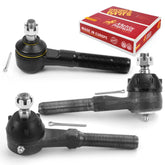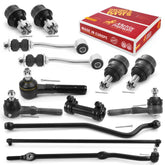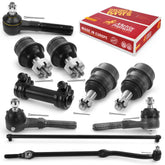What is the Difference Between Vented and Solid Brake Rotors?
It's crucial to understand the differences between vented and solid brake rotors, as they are two of the most commonly used types of brake rotors in vehicles. The primary differences between these two types lie in their design and performance characteristics. Here are the key differences between vented and solid brake rotors to help you make an informed decision when it comes to choosing the right brake rotor for your vehicle:
|
|
Solid Brake Rotors: |
Vented Brake Rotors: |
|
Design: |
Solid rotors are made from a single, continuous piece of metal without any vanes or internal channels. They have a uniform thickness throughout and a smooth, solid surface. |
Vented rotors have internal vanes or fins between the two friction surfaces (rotor faces). These vanes create channels that allow air to flow through the rotor, dividing it into two or more sections. As a result, vented rotors have a two-piece or multi-piece construction. |
|
Heat Dissipation: |
Solid rotors have limited heat dissipation capabilities compared to vented rotors. They tend to retain heat, which can lead to brake fade and reduced performance under heavy braking. |
Vented rotors are designed to dissipate heat more efficiently due to the internal vanes. The airflow between the vanes helps cool the rotor more quickly, reducing the risk of brake fade and maintaining consistent braking performance.
|
|
Weight: |
Solid rotors are generally lighter than vented rotors because they have a simpler, one-piece design. |
Vented rotors are typically heavier due to the additional material in the form of the internal vanes.
|
|
Performance:
|
Solid rotors are suitable for normal driving conditions and are commonly used in most everyday passenger vehicles. They provide adequate braking performance for standard driving situations. |
Vented rotors are often used in performance-oriented and heavier vehicles. They are better equipped to handle high-stress situations, such as aggressive driving, towing, or driving in mountainous terrain, where heat buildup is a concern. |
|
Cost:
|
Solid rotors are generally more cost-effective than vented rotors. They are the standard choice for many vehicles due to their affordability. |
Vented rotors tend to be more expensive because of their more complex construction and superior heat dissipation properties. |
|
Applications:
|
Solid rotors are commonly found in everyday passenger cars and light-duty vehicles where the braking demands are moderate. |
Vented rotors are often used in performance cars, sports cars, heavy trucks, SUVs, and vehicles that require enhanced braking performance. |
If you are in the market for new brake rotors, it's important to understand the difference between vented and solid options. Vented rotors are designed to dissipate heat more effectively, making them ideal for high-performance applications where brake fade can be a concern. On the other hand, solid rotors are better suited for regular driving conditions.
When it comes to choosing the right type of brake rotor for your vehicle, it's important to consider your driving habits and the demands placed on your brakes. That's where Metrix Premium Chassis Parts comes in. They offer a wide range of brake rotors to suit any vehicle and driving style, all with high-quality materials and precise specifications.
If you're not sure which type of brake rotor is best for your vehicle, don't worry. Metrix Premium Chassis Parts offers live support to help you make an informed decision. So why settle for anything less than the best? Choose Metrix Premium Chassis Parts for all your brake rotor needs.









